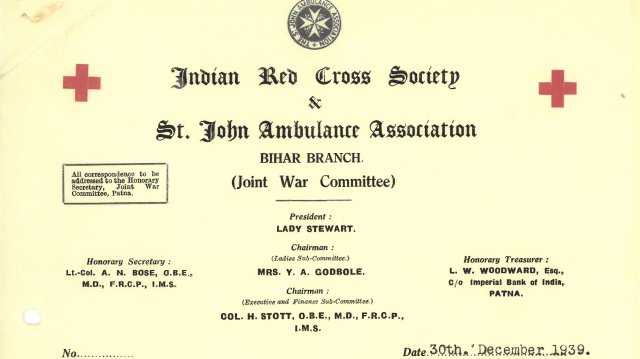Dumka Women’s Contributions to the Indian Red Cross During the War

Together with them, health workers and volunteers from humanitarian organizations such as the Red Cross and St. John Ambulance Association. The field hospitals that are being set up need copious amounts of bandages, linens, clothing, socks, storage- and sandbags. When the military seizes resources and goods it becomes very challenging for the field hospitals to obtain the equipment they need. Consequently, a great need for volunteer labour arises. Women all over the world come together in local communities to support the war effort and help their loved by producing knitted and sewn goods. This request for help also went to the European colonies like India, which was at the time a British colony. In the province of Bihar, the Indian Red Cross Society and the Bihar branch of the St. John Ambulance Association constitute a joint war committee which requests women to donate their time and skills.
“At first our Committee decided not to have any work parties anywhere in Bihar for war purposes as the members thought that most of the things can be had at quite cheap prices from some firms, which give special concession for soldiers, but only lately we decided to make them and that is why we were late in sending circulars and the lists out.”
December 18, 1939¹
In December 1939, the chair of the committee, Kamala Godbole, sends out an appeal in which she encourages volunteer women to produce gifts for the Red Cross. Her letter is sent out on behalf of Lady Elsie Stewart, president of the Joint War Committee and wife of the Governor of Bihar.²
Gift request
She writes that the requested gifts will be used by Expeditionary Forces overseas, which were forces sent out from their home country. The Red Cross' field hospitals in India and abroad will use this equipment as comfort and medical aid for the soldiers.
Meet every week
The volunteer women meet every week in the Dumka Club, and produce substantial amounts of materials for the Red Cross. Both local women and women from various missionary organizations working in Dumka contribute.
The first woman to organize the work is Mrs. V. K. R. Menon. We do not know her first name, but we do know that her husband was Deputy Commissioner,³ the chief administrative officer of the district of Dumka in the contemporary Bihar province. The Norwegian Santal Mission had stations in the Bihar province, among other places, and in the organization's journal Santalen we find mentions of the various men who had the role of Deputy Commissioners. Although Mr. Menon is not mentioned in Santalen, it seems that the various Deputy Commissioners had a friendly relationship with the Santal Mission.⁴
Takes over the leadership
After the Menon family is relocated in 1940, Mrs. Dixie takes over the leadership of the volunteer women's work. According to an article in Santalen, the Dixie family live in the house next door to the Deputy Commissioner.⁵ She continues to organize weekly meetings, first in the Dumka Club, then in her own home. Ingrid Gausdal, missionary in the Santal Mission, is among those who participate. Johannes Gausdal, Ingrid's husband, was field secretary in India during the war years. His story is widely reported in books and journals, including the works about the history of the Norwegian Santal Mission, but Ingrid's story is less well known. Ingrid takes over the leadership of the volunteer work for a short period in 1942, before the spouse of a new Deputy Commissioner, William George Archer, replaces her. Mrs. Archer organizes the volunteer work until April 1944, when Ingrid Gausdal is reinstated as leader for the next two, and final, years.
A small mystery
Why and how this archive material ends up in the Santal Mission's archives is a small mystery, as it stems from Indian branches of the Red Cross and St John Ambulance Association. Perhaps it is Ingrid Gausdal herself who has kept these letters and instructions? Regardless we are grateful that these traces of female missionaries' voluntary and international work during World War II surfaced during the work of organizing the archive from the Norwegian Santal Mission. The archive material testifies to cooperation across organisations, and shows that local civilians, government employees and missionaries came together to support the work of humanitarian organisations. The archive material is also valuable as a source for everyday life at the mission stations, and to how woman missionaries spent their free time. It does not seem unnatural that they had a desire to contribute to the World War, like so many of their compatriots and allies in India, Norway and England. This archive material also testifies to the fact that Ingrid and other women in and around the mission stations might have chosen to support humanitarian rather than military organizations.
By Kristin Ersdal Edland
The Mission and Diakonia Archives, VID
Sources
1. Letter from Chair Kamala Godbole to Mrs. V. K. R. Menon dated December 30, 1939. VID/MDA-A-1549/F/FA/L0040/0003
2.https://www.thegazette.co.uk/London/issue/36033/data.pdf.
Retrieved May 20, 2025
3. Mr. V. K. R. Menon was Deputy Commissioner from 22.09.1939 to 12.08.1940. Retrieved May 20, 2025 from https://dumka.nic.in/list-of-collectors/
4. Ofstad, J. J. (1945, May 15.). The Santal Mission's school and mercy work. Santalen p. 4. Retrieved May 20, 2025 from https://www.nb.no/items/6c865ce1b41d508ff078fdb8bd2c828c?page=0
5. Gausdal, J. (1934, februar 28). Jordskjelv i India. Santalen, p. 16. Retrieved May 20, 2025 from https://www.nb.no/items/dd1bff2ce5ca7a0e1d08b08442c39813?page=1